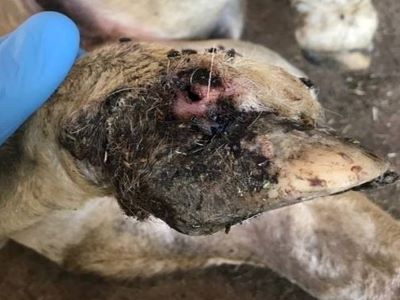Lameness in sheep
Lameness in sheep has been an ongoing issue over successive wet seasons.
Any cause of lameness can cause a significant animal welfare issue as lame sheep often spend less time eating, leading to weigh reduction and production losses. Severe lameness may also result in wool breaks, devaluing fleeces, and can cause late pregnant ewes to develop pregnancy toxaemia (lambing sickness), a frequent cause of death. Joining rates may also be reduced when rams are affected. In addition, stock that are unable to weight bear on one or more limbs are not fit to be transported.
What causes lameness in sheep?
It is important to know what is causing any lameness in your flock. Having an accurate diagnosis when you first notice increasing lameness will give the best outcome possible.
 There are various causes of lameness in sheep including:
There are various causes of lameness in sheep including:
- ovine interdigital dermatitis (scald)
- scabby mouth
- strawberry footrot
- foot abscess
- arthritis
- virulent footrot (reportable)
- benign footrot.
Sheep with wet feet from lush pastures are prone to developing lameness. When a sheep’s feet are constantly exposed to moisture, they become susceptible to bacterial infection. Foot abscess in particular are made much worse when conditions are muddy. Sheep that have been standing in flood waters may have infections of the lower limbs which can be very serious.
Scald (OID): This is inflammation of the skin between the toes that can be caused by several bacteria, none with the ability to cause underrunning. Severe cases can still cause significant pain, irritation, and lameness.
Scabby mouth: Along with lesions around the muzzle, this viral disease can also cause telltale scabbed lesions on the feet, particularly if they are in grazing conditions that can break the skin of the feet and allow the virus to enter, as with pasture growing thorny weeds.
Strawberry footrot: This is a concurrent infection of scabby mouth and Dermatophilus sp. (the “dermo” or “lumpy wool” bacterium). It causes lumpy, generally raw or bloody-appearing lesions around the feet and sometimes legs – it has nothing to do with actual footrot.
Foot abscess: Numerous bacteriological agents can be responsible, but they’re generally normal organisms found on-farm. There is usually obvious swelling, and the claws may be pushed apart so there is a significant gap. Abscess pain generally causes severe “hopping” lameness, but typically only affects one foot of an affected animal, and does not cause the telltale “underrunning” of footrot.
Arthritis: This does not affect feet at all, but rather the joints of the leg. If affecting multiple animals, it is likely to have an infectious origin such as Erysipelas or Chlamydia spp. If isolated to a couple, it is more likely secondary to injury or infection at birth. The lameness can be seen with swollen knees, hocks, and/or pastern joints. Feet can often become overgrown on affected legs, as hoof wear will be abnormal.
Virulent footrot: Virulent strains have the ability to underrun from the heel, right along the bottom of the foot and make the hoof peel off, leading to crippling lameness. These infections often affect more than one foot per animal, generally aren’t swollen, and generally don’t produce the opaque pus seen in abscesses; rather any discharge is generally slimy and blackish where the skin-horn (hoof) junction has been broken down.
Benign footrot: The benign strains generally begin digesting this skin-horn junction, but don’t go as far, and generally resolve with treatment or improved weather. In optimum weather conditions however, they can still cause significant lameness.
Lameness after flooding
Prolonged moisture exposure softens the hooves and the skin of the lower leg, making bruising and penetration injuries more prevalent in hooves, as well as making the skin and hoof tissue less resistant to infections.
Higher bacterial loads present in wet muddy conditions and larger stones that are exposed when topsoil is washed from laneways and yards can contribute to the increased incidence of lameness seen during extended periods of wet conditions.
How to treat lameness in sheep
Minimising distances walked as much as possible, repairing track and yard surfaces, the use of footbaths and ensuring that feed rations have adequate fibre content can decrease the risk for feet issues. Read more about footbathing sheep.
Footbathing is a potential management option to treat foot conditions, however it does have limitations. Bringing sheep into contaminated, muddy sheep yards specifically to footbath can make matters worse by causing a fresh outbreak of foot abscess.
In addition, the benefits gained from footbathing are short-lived. It can also be a very time consuming job for large numbers of sheep, and not everyone has footbaths on hand.
Zinc sulphate mixed to a 10% solution is the safest and most practical chemical to use for footbathing. It will kill superficial skin bacteria and has an astringent/drying effect on skin.
The best benefit is gained from standing sheep in the bath for 10-15 minutes, then allowing the product to dry on the skin (to avoid leaching of the active) before returning to the paddock.
Sheep producers with lameness issues are encouraged to reach out for help and advice. As well as footbathing, antibiotic and pain relief treatments may be of benefit in some situations but will need to be provided by a veterinarian.
Lameness and your biosecurity obligations
Landholders have a legal responsibility to investigate lameness in your sheep. The Biosecurity Act 2015 requires everyone to take reasonable and practical measures to prevent, eliminate or minimise the impact of biosecurity risks. This is your general biosecurity duty. Sheep producers are expected to know that lameness in sheep could be a sign of footrot and as virulent footrot is a notifiable disease in NSW there is a duty to report this to a Local Land Services (LLS) district veterinarian for investigation and advice.